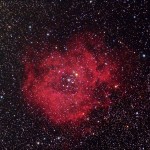A little bit of playing around with a GoPro and some clever software.
A Rosette by any other name . . .
Caldwell 49 is one of the objects in my catalog of images that I’ve wanted to capture for a good long while. It is absolutely massive and generally lends itself well to grab and go wide field imaging. Polar alignment is less critical than at high f/ratio and field rotation is thus less obvious. I still strive for zero rotation and translation and in this case I got that. I only got to capture 35 minutes of data before it disappeared behind a tree so there is still much to be desired. Another attempt at this will be made next year.
Caldwell 49
7 x 5 minutes
Celestron Advanced VX mount
AstroTech AT65EDQ APO quadruplet
Orion StarShoot Pro v2 CCD
Site: Albany, Texas – Fort Griffin State Historic Site – 2016/03/13
(C) 2016 Tim Schuh
You’d think I’d by sick of Orion by now . . .
But I’m not. M42/43 continues to make me smile. The new-ness never seems to wear off even after 15 years of imaging the same region of space every (cooperative) winter. Even from the backyard in the North Dallas suburbs you can get reasonable detail with enough exposure time and a good light pollution filter. That will change as outdoor LED lighting becomes more prevalent in the city.
37 frames of 300 seconds
30 frames of 30 seconds (to get some detail in the central Trapezoid region)
Celestron Advanced VX mount
AstroTech AT65EDQ w/Orion StarShoot Pro v2. Exposure control by Nebulosity 4
Orion Mini-Guider w/Meade DSI Pro operated by OpenPHD2
An elusive winter target finally captured
M103 and M1, the addiction renewed
M1, the Crab Nebula. M103, the Christmas Tree Cluster. Two of my favorite objects. I’ve imaged the M103 cluster several times before but it remains one of my favorites. The obvious grouping of this open cluster gives it a triangular shape and the varied color remind many Westerners of a Christmas Tree. Given that it reaches its highest point in the winter months that naming is fairly obvious.
The Crab Nebula is an object that has eluded me for many years. The star exploded about 7,500 years ago but we only saw the light in 1054 AD as recorded by Chinese astronomers. Capturing the excited Hydrogen ribbons running through the gas cloud has always been difficult for me but I finally got it with 5 hours of data on a nearly perfect night in the middle of the work week. Thank goodness for automagically guiding telescopes and mounts that don’t need constant tinkering!
M103 taken October 10, 2015. 32 frames of 5 minutes.
M1 taken October 13, 2015. 150 frames of 2 minutes.
Both with a Celestron EdgeHD 8″ Schmidt-Cassegrain, Celestron 0.7x focal reducer, Orion StarShoot Pro v2 CCD camera, Hutech IDAS-LPS light pollution filter.
LED Light Pollution begins its slow Intrusion
Cities are the bane of the amateur astronomer. Light pollution continues to grow at an astonishing rate as our cities increase in size and population. That doesn’t mean astronomy is impossible, just more challenging. The use of filters designed specifically to quench low pressure sodium and mercury vapor lights has gone a long way. Enjoy the days of these ionized lamp because they are coming to an end. I’ve begun to see the impact of LED lighting in my own back yard. These next few years will likely be the last I’ll be able to capture nebulae from inside the city so I better enjoy it while I can.
http://www.flagstaffdarkskies.org/for-wonks/lamp-spectrum-light-pollution/
A Dumbbell at last
Finally got some good data on M27 after years of missed attempts. I collected this data from the back yard in Allen, TX. Camera was a Canon T2i with the IR cut filter removed and a custom white balance on a Celestron EdgeHD 8″ guided with a Meade DSI Pro in an Orion MiniGuider. 86 Subexposures of 90 seconds each.
First of several
While I was setting up last night I pointed at the moon to see what it looked like through the EdgeHD 8 on the T2i. Backyard EOS has a planetary mode so I cranked that up and did a couple of quick series. Aligned and stacked with Registax this afternoon and this is the result of a two panel mosaic. I *WILL* be doing this again!


Celestron Edge HD 8
Celestron Advanced VX
Canon T2i
Two sets of 400 frames stacked in Registax and combined in Photoshop. Easy, breesey, lemon squeezey!
M42/M43 – Its that time of year again
Its the end of the calendar year and Orion is high in the sky at a reasonably early hour for urban astronomy. It clears the house around 9:00 so with sunset at 6:30 or so, you can have your high accuracy drift alignment completed by the time Orion is visible over the houses. I took advantage of a very calm, very clear night and collected some 1,300 year old photons for your viewing pleasure. In the end there will be a total of approximately 180 frames in five different lengths. Five seconds, ten, 25, 45, and 60 seconds. Exposures longer than 60 seconds were completely washed out with wide, flat histograms which suggests large areas that are over exposed. It looks like each iteration of stacking will take about fourty-five minutes to an hour on my six-core computer so processing time will be a bit long on this one. Cursory inspection of the first few raw frames showed some significant dust motes so I won’t pretend to get Hubble quality images out of this but I’ll do the best I can.







